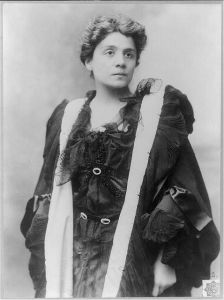2. Life
Eleonora Duse was born On October 3, 1858, to two actors, Vincenzo Alessandro Duse and Angelica Cappelletto. Her grandfather, Luigi Duse, was one of the great Italian actors of his day, amd at least eighteen relatives of his were involved in the theatre when he died. [1] By the age of four, Duse was onstage as Cosette in an adaptation of Victor Hugo’s Les misérables, and by age fourteen she was a leading lady, playing Shakespeare’s Juliet. After losing her mother in 1875, Duse worked towards establishing herself in the title role of Teresa Raquin. From this performance on, she would be known for her portrayals of psychological realism. [2]
Duse continued working until she eventually portrayed Santuzza in Giovanni Verga’s Cavalleria rusticana to critical acclaim in 1884. Eleonora Duse was the first Italian to take on Nora Helmer in 1904, and bring the works of Henrik Ibsen to Italy in the process.[3] By the end of her career, she had mastered many of Ibsen’s greatest roles. In 1885, she pioneered a tour through Latin America.[4] At the age of fifty-one, Duse ended her first career on an exceptionally high note and retired, just before the onset of World War I.[5]
Eleonora Duse was also known for her torrid love affairs. “On 7 September 1881 Duse married a fellow actor, Tebaldo Checchi (1844–1918), and their daughter Enrichetta was born on 7 January 1882. Throughout her life Duse adored Enrichetta, though in her determination to provide her daughter with a respectable, stable upbringing she kept the child at a distance from her profession.”[6] Despite her family life, she today gains more notoriety for her affairs with writers Arrigo Boito and Gabriele D’Annunzio after her marriage had ended.
While Duse continually neglected the thought of penning an autobiography, she managed to leave behind a wealth of letters and annotated scripts, which together form a kind of memoir.[7] She also amassed a personal library in the early decades of the twentieth century, which became the Actresses’ House Library in Rome in 1914. She donated over two thousand books in English, French, and Italian that ranged from literature to philosophy to theatrical texts. Taken as a whole, these collections show how her intellectual education continued over a decade from 1882 to 1892 while affecting her acting techniques and repertoire.[8] Despite knowing multiple languages, Duse continuously performed in Italian, even while performing with French actors at the Théâtre de l’Oeuvre.[9] Italian was an intrinsic part of her craft and mission.
Eleonora Duse came out of retirement by performing Ellida from Ibsen’s The Lady from the Sea in 1921, out of financial necessity (Longman 165). This new career led Duse to a fourth and final tour of the United States possible, beginning in 1923.[10] Duse came to Pittsburgh, PA in her final tour, arriving on April 1, 1924. On the 5th, she contracted a high fever while performing her final role in The Closed Door. Duse died in her hotel room on Easter Monday, April 21, 1924.[11] Throughout her life, Duse struggled with tuberculosis, emphysema, and a possible bipolar disorder, which she took great pains to keep from the public and the press. Dying in a hotel room while on tour in the United States, the at times media-shy star became the subject of international news.[12] Many scholars note that her life ended just as it had begun, while travelling to performances. Today, Duse ranks among actors held in the highest regard and is championed for her contributions to the craft of acting.
- Pontiero, Giovanni, editor and translator. Duse on Tour. The University of Massachusetts Press, 1982. 3.
- Bassnett, Susan. “Duse, Eleonora Giulia Amalia (1858–1924).” Oxford Dictionary of National Biography, Oxford University Press, 2004.
- Mather, Christine C. “The Political Afterlife of Eleonora Duse.” Theatre Survey, vol. 45, no. 1, 2004, 44.
- Fisher, James. “Duse, Eleonora.” American National Biography Online, Oxford Unniversity Press, 2000.
- Mather, 45.
- Bassnett
- Re, Lucia. “Eleonora Duse and Women: Performing Desire, Power, and Knowledge.” Italian Studies, vol. 70, no. 3, 2015, pp. 347-363.
- Sica, Anna De Domenico. “Eleonora Duse’s Library: The Disclosure of Aesthetic Value in Real Acting.” Nineteenth Century Theatre and Film, vol. 37, no. 2, 2010, pp 66-85.
- Mather, 43.
- Londre, Felicia. “Eleonora Duse: An Italian Actress on the American Stage.” Studies in Popular Culture, vol. 8, no. 2, 1985, 60.
- Mather, 46.
- Mather, 42.
Photogaphs: Above left: [Elenora Duse]. Photograph. Retrieved from the Library of Congress, <https://www.loc.gov/item/2005685632/>. Below right: Genthe, Arnold, photographer. Duse, Eleonora, Mme., portrait photograph. Photograph. Retrieved from the Library of Congress, <https://www.loc.gov/item/agc1996009992/PP/>.

